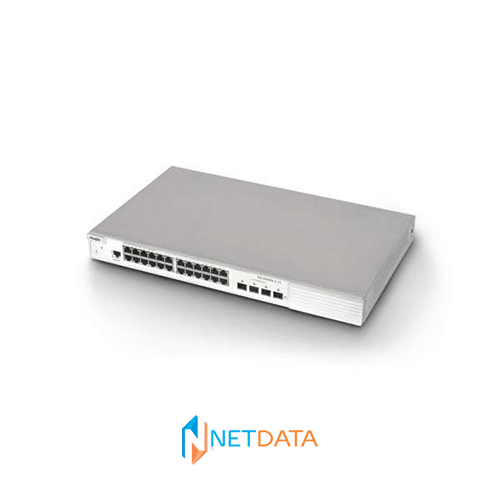
Ruijie RG-S2900G-E V3 Series Switches
Ruijie RG-S2900G-E V3 Series Switches is a collection of next-generation multiservice switches, which offer excellent performance and enhanced security, the switches provide non-blocking wire speed switching performance. Applying the industry-leading hardware design and Ruijie modular RGOS11.X modular operating system, the switch offers better table capacity, better hardware processing performance and easier user operation.
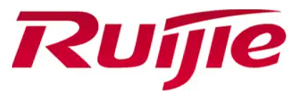
DESCRIPTION
The Ruijie RG-S2900G-E V3 Series Switches is a new generation of multiservice switch sets, which offer outstanding performance and a high level of security. switches provide non-blocking speed switching performance. Applying the industry-leading hardware design and Ruijie modular RGOS11.X modular operating system, the switch offers better capacity, better hardware processing performance and easier user operation.
Product Specifications of the Ruijie RG-S2900G-E V3
Model |
RG-S2928G-E V3 |
RG-S2952G-E V3 |
||
|
Ports |
24 10/100/1000BASE-T ports |
48 10/100/1000BASE-T ports |
||
|
Fan Slots |
Fanless |
Fixed |
||
|
Management Ports |
1 console port |
|||
|
Switching Capacity |
Up to 256Gbps |
|||
|
Packet Forwarding Rate |
Up to 96Mpps |
Up to 132Mpps |
||
|
Port Buffer |
1.5MB |
|||
|
ARP Table |
1,000 |
|||
|
MAC Address |
Up to 16K |
|||
|
Routing Entries |
500 |
|||
|
IP Host Entries |
500 (IPv4/IPv6) |
|||
|
ACL Entries |
Up to 1,500 |
|||
|
ACL |
Standard/Extended/Expert ACL, Extended MAC ACL, ACL 80, IPv6 ACL, ACL logging, ACL counter, ACL remark, Global ACL, ACL redirect |
|||
|
QoS |
802.1p/DSCP/TOS traffic classification; Multiple queue scheduling mechanisms, such as SP, WRR, DRR, SP+WFQ, SP+WRR, SP+DRR; Input port-based speed limit; Port-based traffic recognition; Each port supports 8 queue priorities |
|||
|
VLAN |
4K 802.1q VLANs, Port-based VLAN, MAC-based VLAN, Protocol-based VLAN, Private VLAN, Voice VLAN, QinQ, IP subnet-based VLAN, GVRP |
|||
|
QinQ |
Basic QinQ, Flexible QinQ, 1:1 VLAN switching |
|||
|
Link Aggregation |
AP, LACP, Flow balance |
|||
|
Port Mirroring |
Many-to-one mirroring, One-to-Many mirroring, Flow-based mirroring, Over devices mirroring, VLAN-based mirroring, VLAN-filtering mirroring, AP-port mirroring, RSPAN, ERSPAN |
|||
|
Spanning Tree Protocols |
IEEE802.1d STP, IEEE802.1w RSTP, Standard 802.1s MSTP, Port fast, BPDU filter, BPDU guard, TC guard, TC filter, TC protection, LOOP guard, ROOT guard |
|||
|
DHCP |
DHCP server, DHCP client, DHCP snooping, DHCP relay, IPv6 DHCP snooping, IPv6 DHCP client, IPv6 DHCP relay |
|||
|
Multiple Spanning Tree Protocol (MSTP) Instances |
64 |
|||
|
Maximum Aggregation Port (AP) |
Up to 128 |
|||
|
Multicast |
IGMP v1/v2/v3 snooping, IGMP SGVL/IVGL, IGMP filter, IGMP fast leave, MLD snooping v1/v2 |
|||
|
SDN |
OpenFlow 1.0, future support OpenFlow 1.3 |
|||
|
EEE Format |
Support IEEE 802.3az standard |
|||
|
G.8032 |
Support |
|||
|
L2 Features |
MAC, EEE, ARP, VLAN, Basic QinQ, Felix QinQ, Link aggregation, Mirroring, STP, RSTP, MSTP, Broadcast storm control, IGMP v1/v2/v3 snooping, IGMP SGVL/IVGL, IGMP filter, IGMP fast leave, DHCP, Jumbo frame, RLDP, LLDP, REUP, G.8032 ERPS, Layer 2 protocol tunnel |
|||
|
Layer 2 Protocols |
IEEE802.3, IEEE802.3u, IEEE802.3z, IEEE802.3x, IEEE802.3ad, IEEE802.1p, IEEE802.1x, IEEE802.3ab, IEEE802.1Q (GVRP), IEEE802.1d, IEEE802.1w, IEEE802.1s |
|||
|
Security |
Binding of the IP address, MAC address, and port address; Binding of the IPv6, MAC address, and port address; Filter illegal MAC addresses; Port-based and MAC-based 802.1x; MAB; Portal and Portal 2.0 authentication; ARP-check; DAI; Restriction on the rate of ARP packets; Gateway anti-ARP spoofing; Broadcast suppression; Hierarchical management by administrators and password protection; RADIUS and TACACS+; AAA security authentication (IPv4/IPv6) in device login management; SSH and SSH V2.0; BPDU guard; IP source guard; CPP, NFPP; Port protection |
|||
|
Layer 3 Features |
IPv4 static routing, IPv6 static routing, RIP, RIPng, OSPFv2/v3, ARP proxy, Neighbor Discovery,VRRP |
|||
|
Layer 3 Protocols (IPv4) |
Static routing, RIP, RIPng, OSPFv2/v3 |
|||
|
IPv4 Features |
Ping, Traceroute |
|||
|
IPv6 Features |
0-64 any length mask, ICMPv6, Neighbor Discovery, Manually configure local address, Automatically create local address, IPv6 Ping, IPv6 Tracert, IPv6 extender option head,VRRP v3 |
|||
|
Basic IPv6 Protocols |
IPv6 addressing, Neighbor Discovery (ND), IPv6 ACL, ICMPv6, IPv6 Ping, IPv6 Tracert |
|||
|
IPv6 Routing Protocols |
Static routing, RIPng, OSPFv3 |
|||
|
VSU (Virtual Switch Unit) |
Support (up to 9 stack members,to ensure the effectiveness of the use, 4 members are recommended) |
|||
|
Zero Configuration |
CWMP(TR069) |
|||
|
Reliability |
RAS |
|||
|
Manageability |
SNMPv1/v2c/v3, CLI (Telnet/Console), RMON (1, 2, 3, 9), SSH, Syslog/Debug, RSPAN/ERSPAN, NTP/SNTP, FTP, TFTP, Web, SFLOW,support cable detection and port sleep mode |
|||
|
Smart Temperature Control |
Fanless |
Auto fan speed adjustment; Fan malfunction alerts; Fan status check |
||
|
Other Protocols |
FTP, TFTP, DNS client, DNS static |
|||
|
Dimensions |
440 × 260 × 43.6 |
|||
|
Rack Height |
1RU |
|||
|
Weight |
≤3.5kg |
≤4kg |
||
|
MTBF |
482560 hours |
372690 hours |
||
|
Lightning Protection |
6KV |
|||
|
Power Supply |
AC input: HVDC input: |
|||
|
Power Consumption |
≤24W |
≤40W |
||
|
Temperature |
Operating temperature: 0°C to 50°C |
|||
|
Storage temperature: -40°C to 70°C |
||||
|
Humidity |
Operating humidity: 10% to 90%RH |
|||
|
Storage humidity: 5% to 95%RH |
||||
|
Operating Altitude |
-500m to 5,000m |
|||
|
Safety Standards |
IEC 60950-1,EN60950-1 |
|||
|
Emission Standards |
EN 300 386, EN 55032, EN 61000-3-2, EN 61000-3-3, EN 55024, EN 61000-4-2, EN 61000-4-3, EN 61000-4-4, EN 61000-4-5, EN 61000-4-6, EN 61000-4-8, EN 61000-4-11 |
|||
Ruijie’s Comprehensive Security Policy
The Ruijie RG-S2900G-E V3 Series effectively prevents and controls the spread of viruses from breach attacks by various inherent mechanisms such as anti-DoS attacks, hacker IP scanning, illegal ARP packet checking and multiple hardware ACL policies.
● Industry leading CPU protection mechanism: CPU Protection Policy (CPP) provides policies to protect CPUs from switches. In a networked environment, multiple attack packets spread, which can cause high CPU usage of the switch, affect protocol running and even difficulty in switch management. For this purpose, the CPU switch must be protected, that is, traffic control and priority-based processing must be carried out for various incoming packets to ensure the processing capability of the CPU switch.
○ CPP can effectively prevent malicious attacks on the network and provide a clean environment for legitimate protocol packets.
○ CPP is enabled by default. This provides protection during operation of the entire switch.
● IP / MAC binding: Apply flexible port or system binding to users’ IP addresses and MAC addresses, strictly restricting user access on ports or system-wide.
● DHCP snooping : Allow DHCP response only from trusted ports; based on DHCP listening and by dynamically monitoring ARP and checking the user’s IP address, instantly removing illegal packets inconsistent with binding entries to effectively prevent ARP fraud and sources of IP address fraud.
● Secure Shell and SNMPv3 : Secure Shell (SSH) and Simple Network Management Protocol v3 (SNMPv3) cryptographic network protocols ensure the security of management information. Provides services such as multi-element binding, port security, time-based ACLs and bandwidth limiting to block unauthorized users.
● NFPP : The Network Foundation Protection Policy (NFPP) provides a guard for switches. Malicious attacks are always found in networked environments. These attacks carry heavy loads to the switch, resulting in high CPU usage and operational issues. These attacks are as follows:
Attacks Denial of Service (DoS) attacks can consume large amounts of memory, entries, or other switch resources, leading to system outages.
○ massive attack traffic directed to the CPU, occupying the entire CPU bandwidth. In this case, normal protocol trafc and management trafc cannot be processed by the CPU, causing protocol or management failures. Forwards on data fields will also be affected and the whole network will be abnormal.
NFPP can effectively protect the system from these attacks. In the face of attacks, NFPP maintains the running of various system services with low CPU loads, thereby ensuring the stability of the entire network.
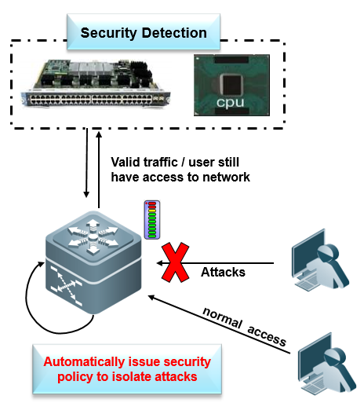
Virtual Switch Unit (VSU)
Virtual Switch Unit technology, or VSU for short, allows the interconnection of multiple physical devices by virtualizing them into one logical device. Logical devices use a single IP address, Telnet processing, command line interface (CLI), and allow automatic version inspection and configuration. From a user perspective, the benefits are doubled work efficiency and an improved user experience of multiple devices operating at the same time. And they only need to manage one device. VSU technology also offers the following benefits:
● Easy management : Administrators can centrally manage all devices simultaneously. No more need to configure and manage individual switches.
● Simplified typology : VSU is considered a single switch on the network. With aggregation link connections and peripheral networking devices, the MSTP protocol is unnecessary because there is no Layer 2 loop network. All protocols operate as a single switch.
● Millisecond failover : VSU and peripheral devices are connected via an aggregation link. After any device or link failure, link failure to other members only takes 50 to 200 ms.
● Excellent scalability : Hot swappable network, all devices leaving or joining the virtual network cause zero impact on other devices.
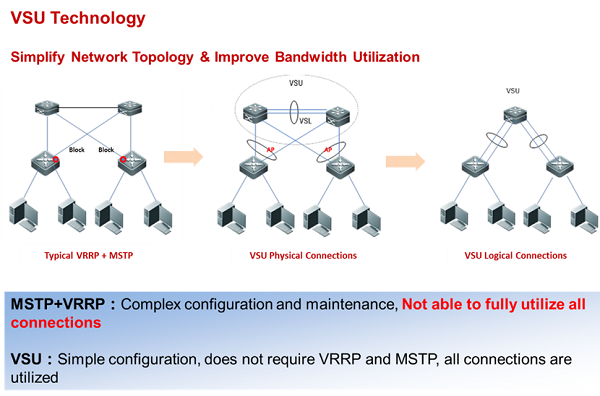
High Reliability
The RG-S2900G-E V3 series supports spanning tree protocols from 802.1d, 802.1w, and 802.1s to ensure fast convergence, improve fault tolerance capabilities, ensure stable network running and balance link load, and provide redundant links.
● Virtual Router Redundant Protocol (VRRP): Effectively ensures network stability.
● Rapid Link Detection Protocol (RLDP) : Detects link connectivity and whether the optical fiber link is normal from both ends, and supports port-based loop detection function to prevent network errors caused by loops generated by device connections such as hubs to port.
● Ethernet Ring Protection Switching (ERPS) (G.8032) : Implement loop blocking and link recovery on the master device. Other devices immediately report the link status to the master device. Without bypassing other standby devices, the interruption failure and loop recovery times are therefore faster than that of STP. ERSP link failure rates can be resolved in milliseconds under ideal conditions.
● Rapid Ethernet Uplink Protection Protocol (REUP): When Spanning Tree Protocol (STP) is disabled, Rapid Ethernet Uplink Protection Protocol (REUP) can provide basic link redundancy via fast uplink protection function and provides faster subconductor level error recovery than STP.
Software-Defined Networking (SDN)
With an all-new hardware architecture and Ruijie’s latest RGOS11.X modular operating system, the RG-S2900G-E V3 Series fully supports OpenFlow 1.3. in collaboration with Ruijie SDN controllers, it forms large-scale Layer 2 network architectures with ease. A smooth upgrade of the entire network to SDN one is also enabled. The switch series therefore greatly simplifies network management and minimizes network deployment savings.
Energy efficiency
The Ruijie RG-S2900G-E V3 Series adopts the latest generation hardware architecture with highly energy efficient circuit design and component selection. This device succeeded in reducing energy consumption. Apart from maximized energy savings, the RG-S2900G-E V3 Series also significantly reduces noise pollution. All models in this series use a variable speed axial fan, which supports intelligent speed adjustment based on the current ambient temperature. All features allow the switch to work smoothly and reduce power consumption and noise pollution at the same time.
The RG-S2900G-E V3 series also supports auto off mode. When an interface is off for a certain period of time, the system will automatically shut it down for extra energy efficiency. EEE energy saving mode is another excellent feature. The system will automatically change the idle port to energy saving mode. When there is a new packet, the system will issue a listening stream to the port to continue service.
Easy Tissue Maintenance
The Ruijie RG-S2900G-E V3 Series supports many features such as SNMP V1 / V2 / V3, RMON, Syslog, and log backup and configuration using USB for routine diagnosis and maintenance. Administrators can use various methods for easier management and such as CLI, web management, Telnet, CWMP (TR069), etc.
The RG-S2900G-E V3 series fully supports RG-SNC (Smart Network Commander) which is a network management system launched by Ruijie Networks specially designed for network performance management and configuration. With a friendly browser UI, SNC provides various features such as network topology view, device management, performance monitoring, configuration & software management, real-time alarm and log & report management.
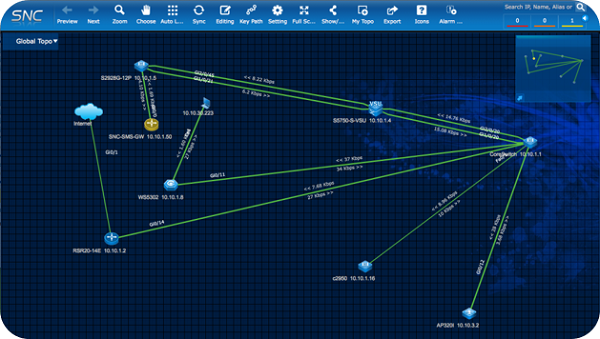
Design For Durability
In corrosive gases, high humidity environments, electronic products will accelerate corrosion, reliability and service life will be shortened. However, the access switch deployment environment is different, there may be a lack of temperature and humidity regulation and close proximity to sources of pollution or the sea. Designed for durability, the Ruijie RG-S29E V3 series switch can operate stably in a variety of usage environments.
Fanless design: If the air flow on the surface of the electronic product is too fast, it will increase the gas corrosion rate of the equipment and shorten the life of the equipment. For low power products, the fanless design is the most effective anti-corrosion measure. The RG-S2928G-E uses a fanless design to reduce corrosive gases and dust ingress.
Applications of the Ruijie RG-S2900G-E V3
The gigabit RG-S2900-E / P V3 safe and smart access switch is ideal for the following and the same scenario
● Full gigabit access to large-scale enterprise and institutional LANs, such as government buildings, large enterprises, energy, and metallurgical enterprises Full gigabit access to server clusters
● Secure access through flexible and diverse security control policies that can defend and control viruses and network attacks
● Full gigabit access to business systems, such as hospitals, libraries, exhibition centers, and websites
This network topology allows the Ruijie RG-S2900-E V3 series to work with converged switches (eg RG-S5750-H) across buildings and core switches (eg RG-N18000 series) in core areas to provide gigabit service for desktops . 10G high bandwidth links meet in the core area to meet the needs of users to increase the volume of information in universities, libraries, laboratories, financial centers, offices and exhibition centers.
Informasi Pemesanan dari Ruijie RG-S2900G-E V3
Model |
Description |
| RG-S2928G-E V3 | 24 10/100/1000BASE-T ports
4 1G SFP ports (non-combo) |
| RG-S2952G-E V3 | 48 10/100/1000BASE-T ports
4 1G SFP ports (non-combo) |
| Mini-GBIC-GT | 1000BASE-GT mini GBIC Transceiver |
| MINI-GBIC-SX-MM850 | 1000BASE-SX mini GBIC Transceiver (850nm) |
| MINI-GBIC-LX-SM1310 | 1000BASE-LX mini GBIC Transceiver (1310nm) |
| MINI-GBIC-LH40-SM1310 | 1000BASE-LH mini GBIC Transceiver (1310nm, 40km) |
| MINI-GBIC-ZX50-SM1550 | 1000BASE-ZX mini GBIC Transceiver (1550nm, 50km) |
| MINI-GBIC-ZX80-SM1550 | 1000BASE-ZX mini GBIC Transceiver (1550nm, 80km) |
| MINI-GBIC-ZX100-SM1550 | 1000BASE-ZX mini GBIC Transceiver (1550nm, 100km) |
| GE-SFP-LX20-SM1310-BIDI |
1000BASE-LX, SFP Transceiver, BIDI-TX1310/RX1550,20km,LC |
| GE-SFP-LX20-SM1550-BIDI | 1000BASE-LX, SFP Transceiver, BIDI-TX1550/RX1310,20km,LC |
| GE-SFP-LH40-SM1310-BIDI | 1000BASE-LH, SFP Transceiver, BIDI-TX1310/RX1550,40km,LC |
| GE-SFP-LH40-SM1550-BIDI | 1000BASE-LH, SFP Transceiver, BIDI-TX1550/RX1310,40km,LC |

